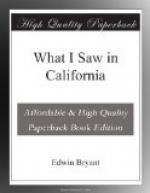The Senora L. is the first Hispano-American lady I have seen since arriving in the country. She was dressed in a white cambric robe, loosely banded round the waist, and without ornament of any kind, except several rings on her small delicate fingers. Her complexion is that of a dark brunette, but lighter and more clear than the skin of most Californian women. The dark lustrous eye, the long black and glossy hair, the natural ease, grace, and vivacity of manners and conversation, characteristic of Spanish ladies, were fully displayed by her from the moment of our introduction. The children, especially two or three little senoritas, were very beautiful, and manifested a remarkable degree of sprightliness and intelligence. One of them presented me with a small basket wrought from a species of tough grass, and ornamented with the plumage of birds of a variety of brilliant colours. It was a beautiful specimen of Indian ingenuity.
Retiring to bed about ten o’clock, I enjoyed, the first time for four months, the luxury of clean sheets, with a mattress and a soft pillow. My enjoyment, however, was not unmixed with regret, for I noticed that several members of the family, to accommodate us with lodgings in the house, slept in the piazza outside. To have objected to sleeping in the house, however, would have been considered discourteous and offensive.
September 18.—Early this morning a bullock was brought up and slaughtered in front of the house. The process of slaughtering a beef is as follows: a vaquero, mounted on a trained horse, and provided with a lasso, proceeds to the place where the herd is grazing. Selecting an animal, he soon secures it by throwing the noose of the lasso over the horns, and fastening the other end around the pommel of the saddle. During the first struggles of the animal for liberty, which usually are very violent, the vaquero sits firmly in his seat, and keeps his horse in such a position that the fury and strength of the beast are wasted without producing any other result than his own exhaustion. The animal, soon ascertaining that he cannot release himself from the rope, submits to be pulled along to the place of execution. Arriving here, the vaquero winds the lasso round the legs of the doomed beast, and throws him to the ground, where he lies perfectly helpless and motionless. Dismounting from his




